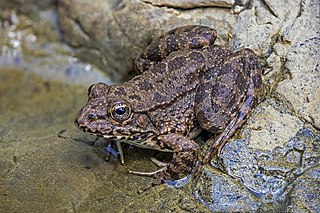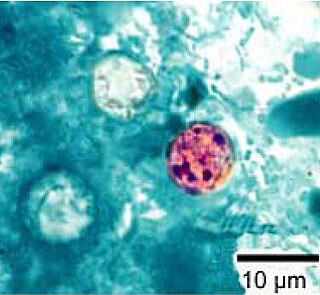Related Research Articles

A frog is any member of a diverse and largely carnivorous group of short-bodied, tailless amphibians composing the order Anura. The oldest fossil "proto-frog" Triadobatrachus is known from the Early Triassic of Madagascar, but molecular clock dating suggests their split from other amphibians may extend further back to the Permian, 265 million years ago. Frogs are widely distributed, ranging from the tropics to subarctic regions, but the greatest concentration of species diversity is in tropical rainforest. Frogs account for around 88% of extant amphibian species. They are also one of the five most diverse vertebrate orders. Warty frog species tend to be called toads, but the distinction between frogs and toads is informal, not from taxonomy or evolutionary history.

Eimeria is a genus of apicomplexan parasites that includes various species capable of causing the disease coccidiosis in animals such as cattle, poultry and smaller ruminants including sheep and goats. Eimeria species are considered to be monoxenous because the life cycle is completed within a single host, and stenoxenous because they tend to be host specific, although a number of exceptions have been identified. Species of this genus infect a wide variety of hosts. Thirty-one species are known to occur in bats (Chiroptera), two in turtles, and 130 named species infect fish. Two species infect seals. Five species infect llamas and alpacas: E. alpacae, E. ivitaensis, E. lamae, E. macusaniensis, and E. punonensis. A number of species infect rodents, including E. couesii, E. kinsellai, E. palustris, E. ojastii and E. oryzomysi. Others infect poultry, rabbits and cattle. For full species list, see below.

Sarcocystis is a genus of protozoan parasites, with many species infecting mammals, reptiles and birds. Its name is dervived from Greek sarx = flesh and kystis = bladder.

Hylarana guentheri is a species of frog in the family Ranidae. It was formerly placed in the genus Rana. It is found in China, Hong Kong, Macau, Taiwan, Vietnam, and possibly Cambodia and Laos. An introduced population is found on Guam. It can live as high as 1100 meters above sea level. An alternate common name is Günther's Amoy frog, and the honorific is often spelled "Guenther's".

Haemoproteus is a genus of alveolates that are parasitic in birds, reptiles, and amphibians. Its name is derived from Greek: haima 'blood' and Proteus, a sea god that had the power to assume various shapes. The name Haemoproteus was first used in the description of H. columbae in the blood of the pigeon Columba livia by Walther Kruse in 1890. This was also the first description of this genus. Two other genera—Halteridium and Simondia—are now considered to be synonyms of Haemoproteus.

Pelophylax is a genus of true frogs widespread in Eurasia, with a few species ranging into northern Africa. This genus was erected by Leopold Fitzinger in 1843 to accommodate the green frogs of the Old World, which he considered distinct from the brown pond frogs of Carl Linnaeus' genus Rana.
Goussia is a taxonomic genus, first described in 1896 by Labbé, containing parasitic protists which largely target fish and amphibians as their hosts. Members of this genus are homoxenous and often reside in the gastrointestinal tract of the host, however others may be found in organs such as the gallbladder or liver. The genera Goussia, as current phylogenies indicate, is part of the class Conoidasida, which is a subset of the parasitic phylum Apicomplexa; features of this phylum, such as a distinct apical complex containing specialized secretory organelles, an apical polar ring, and a conoid are all present within Goussia, and assist in the mechanical invasion of host tissue. The name Goussia is derived from the French word gousse, meaning pod. This name is based on the bi-valve sporocyst morphology which some Goussians display. Of the original 8 classified Goussians, 6 fit the “pod” morphology. As of this writing, the genera consists of 59 individual species.
Dactylosoma is a genus of parasitic alveolates of the phylum Apicomplexa.

Cyclospora is a genus of apicomplexan parasites. It includes the species Cyclospora cayetanensis, the causative agent of cyclosporiasis. Members of Cyclospora are characterized as having oocysts with two sporocysts, each containing two sporozoites.

Cystoisospora is a genus of parasitic alveolates belonging to the phylum Apicomplexa.
Atoxoplasma is a genus of parasitic alveolates in the phylum Apicomplexa. The species in this genus infect birds. They are spread by the orofaecal route.
Merocystis is a genus in the phylum Apicomplexa.
Lankesterella is a genus in the phylum Apicomplexa. Species in this genus infect amphibians, reptiles and birds.
References
- ↑ Lieberkühn, Nathanael (2023). Über die Psorospermien. Philipps-Universität Marburg.
- 1 2 Modrý D, Slapeta JR, Jirků M, Oborník M, Lukes J, Koudela B (2001). "Phylogenetic position of a renal coccidium of the European green frogs, 'Isospora' lieberkuehni Labbé, 1894 (Apicomplexa: Sarcocystidae) and its taxonomic implications". Int. J. Syst. Evol. Microbiol. 51 (Pt 3): 767–772. doi: 10.1099/00207713-51-3-767 . PMID 11411696.
- ↑ Golemansky, V. and Bitseva, V. 1975. Studies upon the protozoan parasitic fauna on amphibia in Bulgaria. I. Bombina variegata (L.). Acta Zoologica Bulgaria 1: 23-32.
- ↑ Tokiwa, Toshihiro; Chou, Shyun; Tochigi, Yuki; Katayama, Kentaro; Duszynski, Donald W. (2021-08-01). "Hyaloklossia Labbé, 1896 (Alveolata: Apicomplexa) in frogs: Description of a new species and proposing a new subfamily to accommodate these enigmatic parasites". International Journal for Parasitology: Parasites and Wildlife. 15: 199–207. doi:10.1016/j.ijppaw.2021.05.005. ISSN 2213-2244. PMC 8187853 . PMID 34141567.
- ↑ Tokiwa, Toshihiro; Kezuka, Chiho; Yamada, Shoto; Chou, Shyun; Nakamura, Shin-ichi (2022-10-01). "Detection and characterization of Hyaloklossia kasumiensis (Apicomplexa: Sarcocystidae) from Nagoya Daruma pond frog, Pelophylax porosus brevipodus". Parasitology International. 90: 102614. doi: 10.1016/j.parint.2022.102614 . ISSN 1383-5769.
- ↑ Tokiwa, Toshihiro; Chou, Shyun; Morizane, Riona; Yoshikawa, Natsuhiko (2022-04-01). "Black-spotted pond frog Pelophylax nigromaculatus as a new host for the renal coccidian genus Hyaloklossia (Alveolata: Apicomplexa)". International Journal for Parasitology: Parasites and Wildlife. 17: 194–198. doi: 10.1016/j.ijppaw.2022.02.003 . ISSN 2213-2244. PMC 8844192 .
- ↑ Levine, N. D.; Nye, R. R. (January 1977). "A survey of blood and other tissue parasites of leopard frogs Rana pipiens in the United States". Journal of Wildlife Diseases. 13 (1): 17–23. doi: 10.7589/0090-3558-13.1.17 . ISSN 0090-3558. PMID 300116.